“Do you wash potatoes before storing?” This lingering question often arises in your mind immediately after the bountiful harvest of your precious tubers. Striking a balance between ensuring cleanliness and preserving the optimal quality and extended shelf life of mature potatoes can be a perplexing challenge.
Let’s explore washing potatoes before preserving them, important factors to consider when storing potatoes, and how to select the best and fresh potatoes for use!
Contents
Do You Need to Wash Potatoes Before Storing Them?
The decision to wash or rinse potatoes before storage depends on several factors.
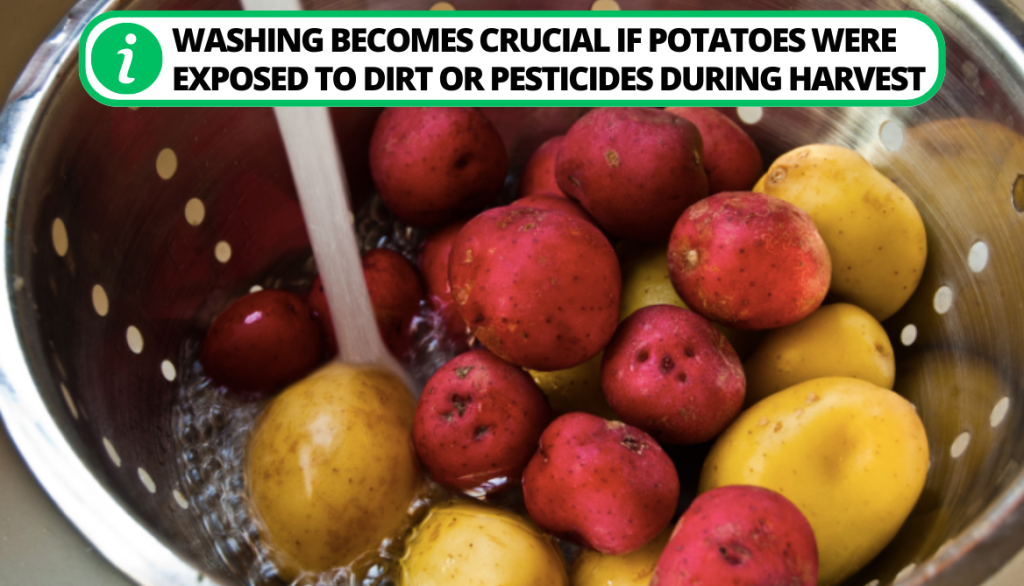
- Cleanliness and Exposure to Pollutants: Washing potatoes might not be essential if they are clean and have not been exposed to pollutants. However, washing becomes crucial if they were exposed to dirt or pesticides during harvest.
- Storage Duration: Longer storage durations may benefit from rinsing potatoes to prevent spoiling due to the sticking of wet soil. However, too much moisture added during washing might result in sprouting or rotting, so it’s crucial to let the potatoes completely air dry before storing them.
Whether or not to wash tubers before preserving them may also depend on your preference and sanitary considerations.
Best Time to Stop Watering Your Potatoes
To ensure optimal potato quality for storage, it is important to stop watering potatoes at the right time. Here are some guidelines to help you.
1. Harvest Time
Typically, you should stop watering about 2 to 3 weeks before harvesting potatoes. This timing allows the potato plants to start maturing. By reducing water availability, the potatoes undergo skin thickening making them less prone to damage during harvesting and storage.
To avoid spoilage, harvest potatoes when the foliage has died back and the skins are firm, typically about two to three weeks after the plants have finished flowering.
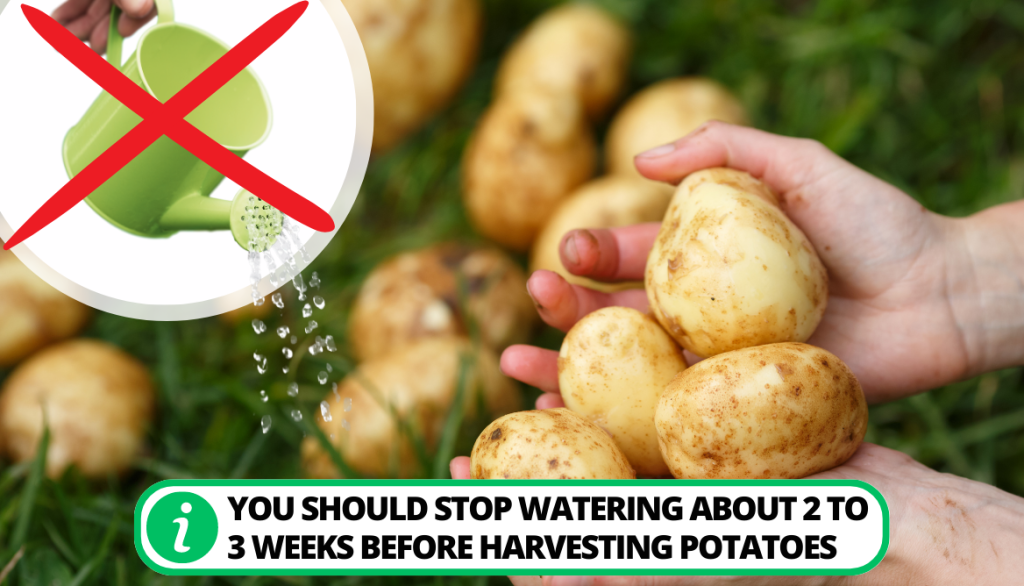
2. Monitor Vine Health
As the plants near maturity, the vines will start to naturally die back. This is a sign that the potato plants are reaching the end of their life cycle and that you should gradually reduce watering.
However, if the vines become severely damaged or infected by diseases, it may be necessary to stop watering earlier to prevent further spread of the disease to the potato tubers.
3. Soil Moisture Content
Potatoes require well-drained soil, and over-watering can lead to waterlogged conditions, which can promote rot and other storage issues. As the potatoes near maturity, the soil should be slightly dry but not completely parched.
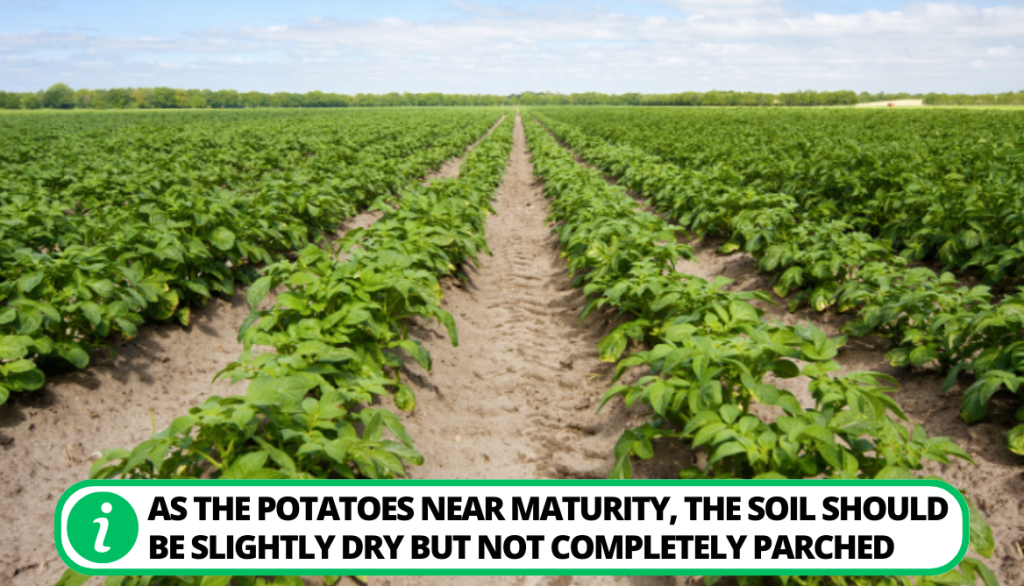
4. Environmental Factors
If you are experiencing a period of heavy rainfall or high humidity, you need to adjust your watering schedule. Excess moisture from rainfall can affect the quality and storage term of potatoes grown.
In such cases, you must stop watering earlier to compensate for the extra moisture. However, homegrown potatoes under the shed or in the house might not be disturbed by excessive rainfall.
Key Factors To Ensure Long-Term Potato Preservation and Quality
When storing potatoes after washing them, there are several important factors to consider. Here are the key factors that you should take care of:
1. Humidity
Keeping potatoes in an environment with the right humidity is essential to maintain their quality and prevent them from sprouting or rotting. Ideally, the humidity level for stored potatoes should be around 85 to 95%. Here’s why humidity is crucial:
- Potatoes have a high moisture content, and storing them in a humid environment helps prevent them from drying out and becoming shriveled.
- Higher humidity levels discourage the growth of sprouts on potatoes. This is particularly important if you plan to preserve potatoes for an extended period.
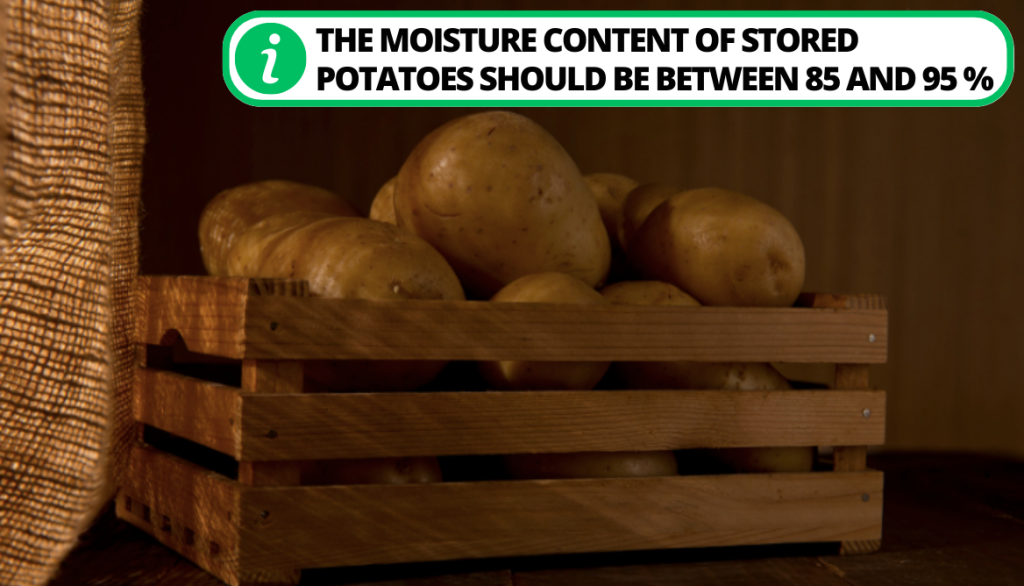
2. Darkness
Newly harvested potatoes should be stored in a dark area to protect them from exposure to light. Light can cause potatoes to turn green and develop a bitter taste. To ensure optimal storage conditions, follow these guidelines:
- Keep potatoes in a cool, dark well-ventilated place that is shielded from natural and artificial light sources. This helps prevent the production of solanine, a chemical compound that forms in response to light exposure and can be toxic if consumed in large quantities.
- Choose opaque containers, or burlap sacks to store potatoes in the dark.
3. Storage Temperature
Potatoes should be stored in a cool and consistent temperature environment. The temperature for potatoes is around 45 to 50°F (7 to 10°C). Avoid storing them at storage temperatures below 40°F (4°C) as it can cause starches to convert into sugars, affecting taste and texture.
Although potatoes can be stored in freezing temperatures, it is important to blanch them before freezing to preserve their texture and color. Properly stored frozen potatoes can be kept for 2-3 months.
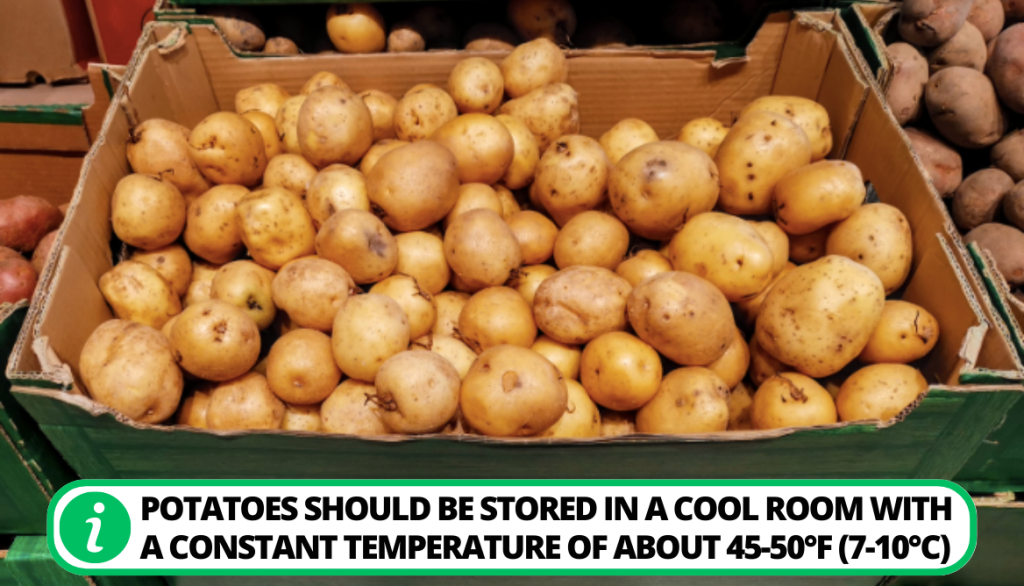
4. Ventilation
Proper ventilation is necessary for potatoes stored to prevent the buildup of excess moisture and to ensure a fresh supply of air. Adequate airflow helps reduce the risk of rotting and extends the shelf life of potatoes.
- Avoid tightly sealed containers or paper bag that can trap moisture and promote rot.
- If using containers or bins, ensure they have perforations to facilitate airflow.
This helps maintain an optimal environment and prevents the accumulation of gases that can accelerate spoilage.
Tips on Keeping Your Harvested Potatoes Fresh
Following these suggestions can be quite beneficial when it comes to storing harvested potatoes and keeping them fresh for an extended length of time.
- Keep away from some fruits and vegetables: Keep healthy potatoes away from fruits such as apples, which release ethylene gas that can accelerate the sprouting process. If possible, store tubers away from other vegetables to prevent them from absorbing odors, which can affect the flavor of your potato recipes.
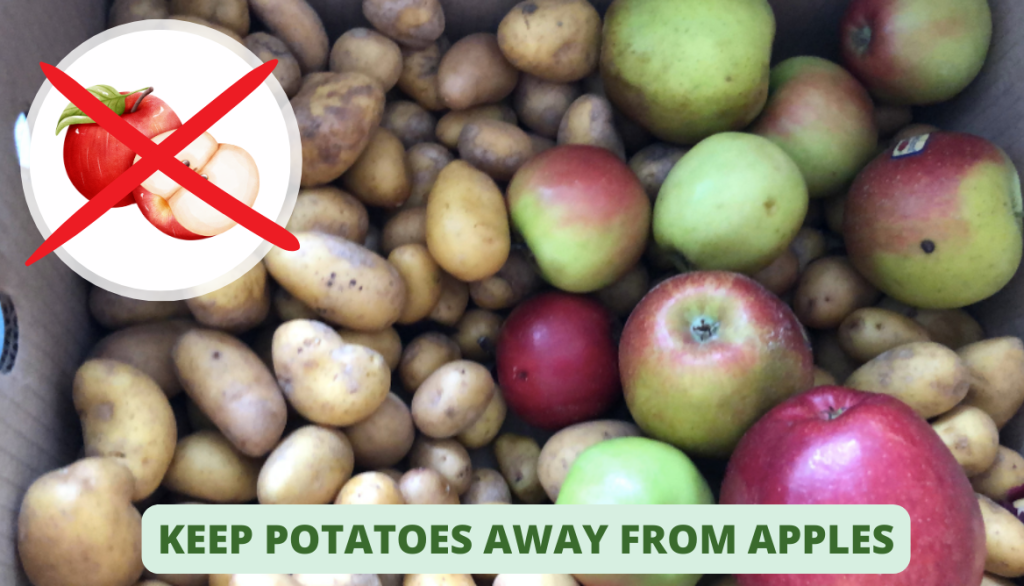
- Storage: If you have a large potato harvest, consider storing different potato varieties separately, as some kinds may have longer or shorter storage lives. Consider storing smaller quantities of potatoes in your kitchen pantry or a cool basement, while larger amounts can be stored in a root cellar or a cool garage.
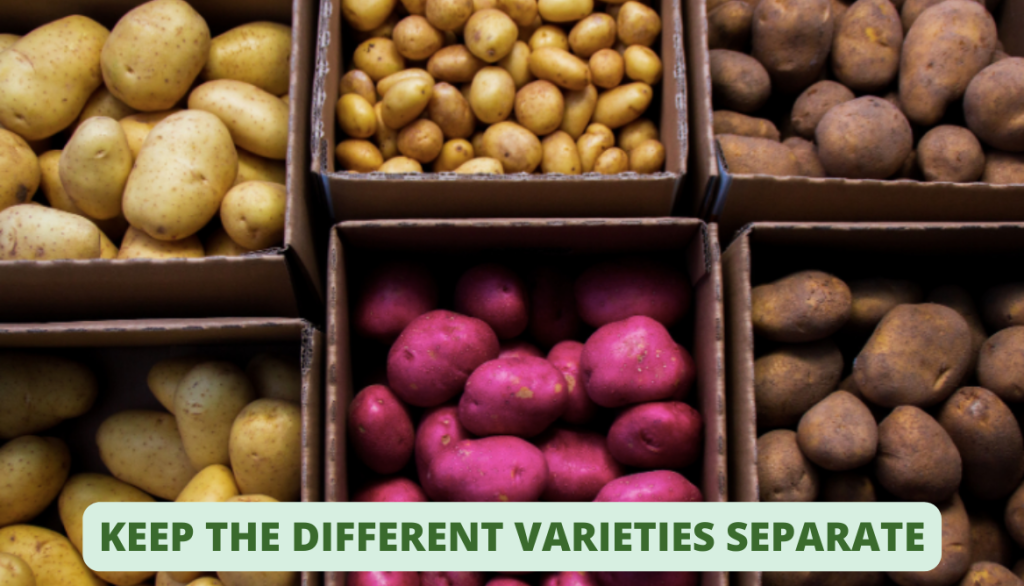
- Scrape the dirt off, not wash: Avoid washing mature potatoes before storage if they don’t come in contact with harmful chemicals, as it can remove their natural protective coating. Instead, gently brush off excess sandy soil, sticky clay, or loamy soil on potato skin before storing.
- Old potatoes: Use the older potatoes first to ensure you consume them before they start to deteriorate in quality.
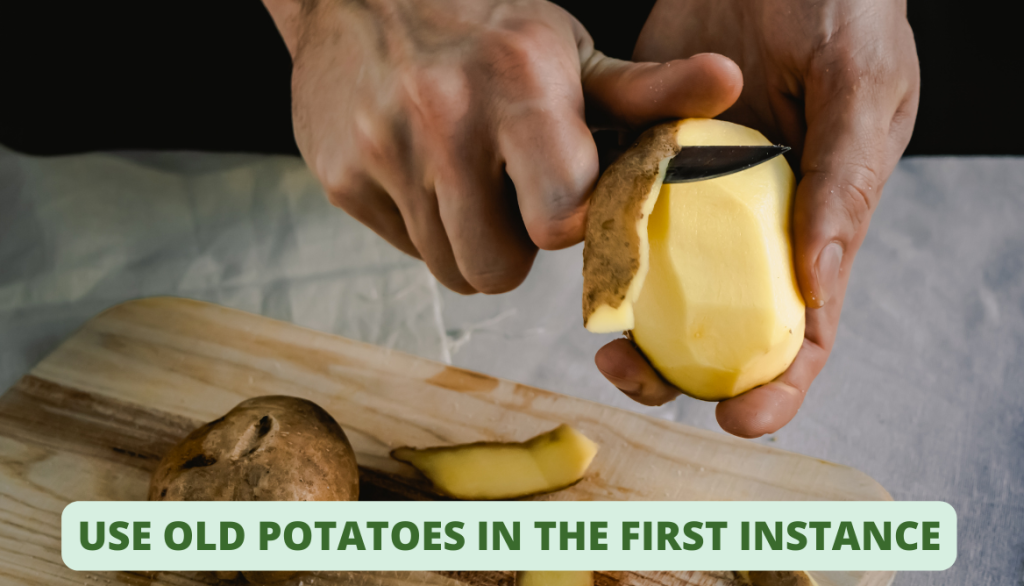
- Immature potatoes: It is generally not recommended to store immature potatoes for long periods because they have a higher moisture content and are more prone to spoilage.
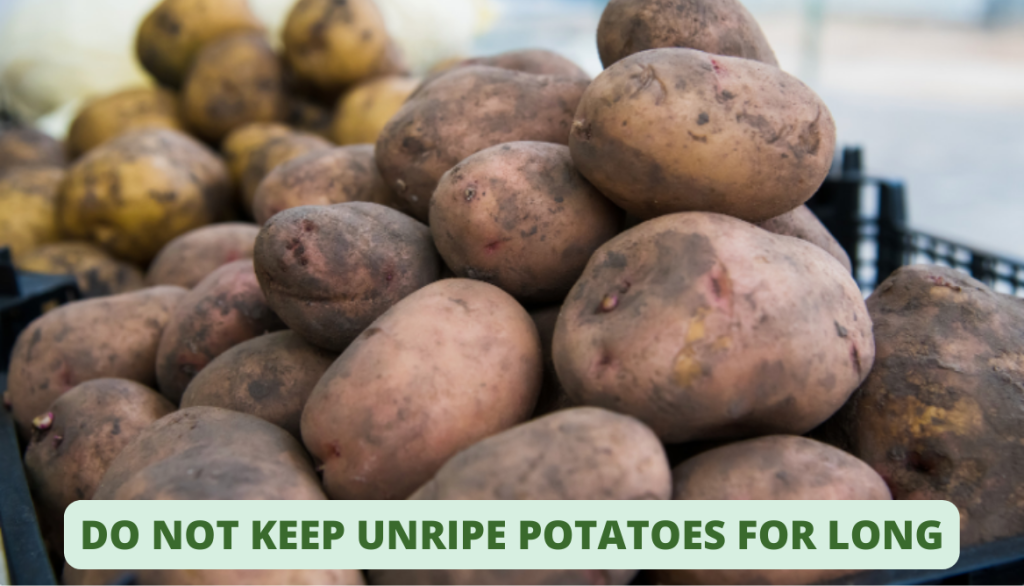
- Extra potatoes: If you have extra potatoes that you can’t use up before they start to go bad, think about canning, freezing, or dehydrating them.
- Sweet potato taste: To minimize the sweet taste in stored potatoes, it is beneficial to remove them from storage a few days before cooking, allowing the excess sugar to convert back to starch through a process known as “reconditioning.”
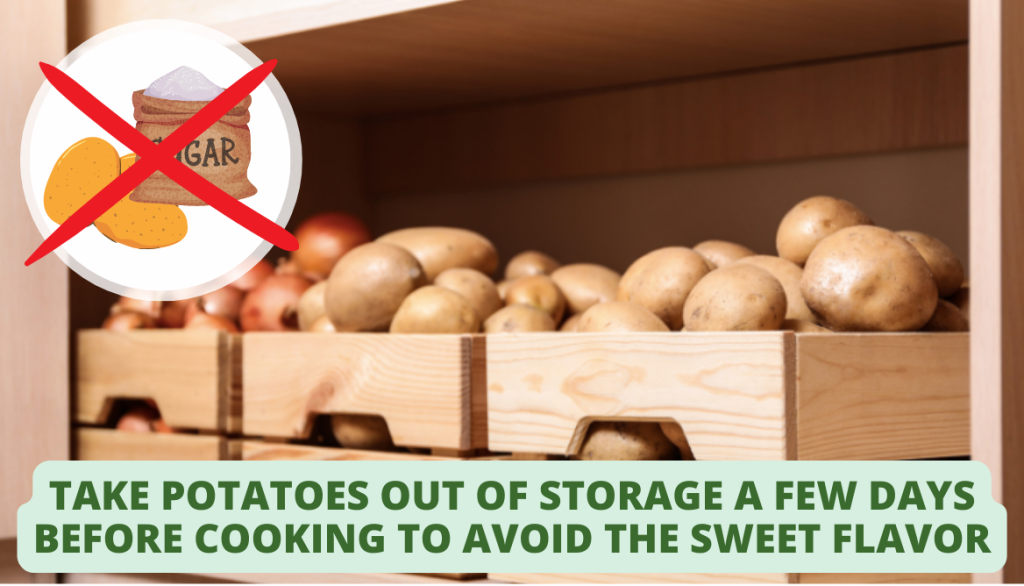
- Cooked potato: Also, you might need to store your leftover cooked potatoes. All you need to do is cool them down, place them in an airtight container, and refrigerate for 3-5 days.
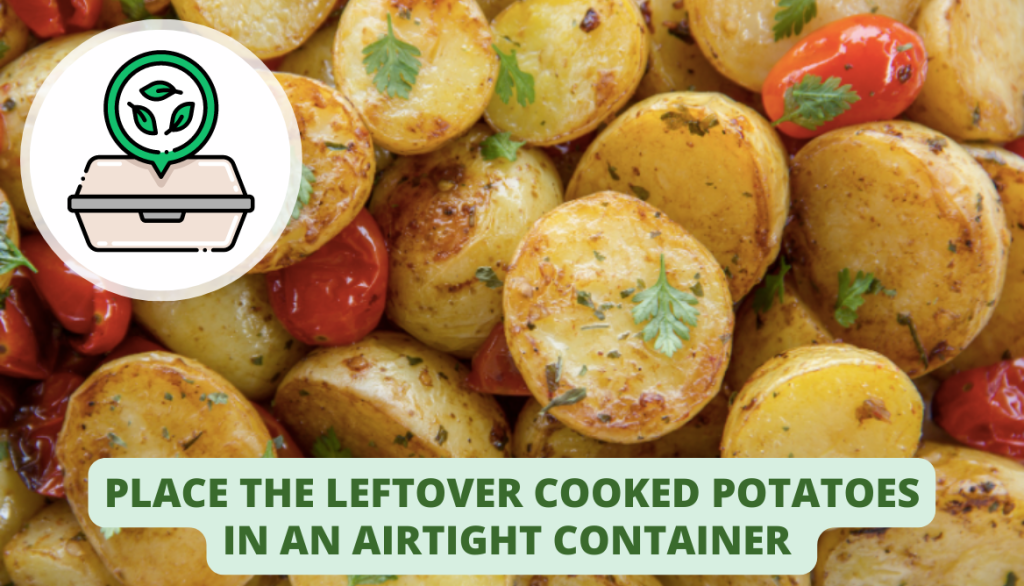
Here’s an example of a table comparing potatoes with long and short storage lives:
Potatoes | Storage Life |
Russet Burbank: | Long-term |
Yukon Gold: | Long-term |
Red Pontiac: | Long-term |
Fingerling: | Short-term |
Purple Peruvian: | Short-term |
Adirondack Blue: | Short-term |
How To Select The Best And Fresh Potatoes
There are a few essential factors to consider while choosing the best and freshest potatoes. Here are some ideas to help you:
1. Firm to the Touch
When picking up a potato, it should feel firm and solid. Avoid potatoes that feel soft or spongy, as they may indicate decay or spoilage.
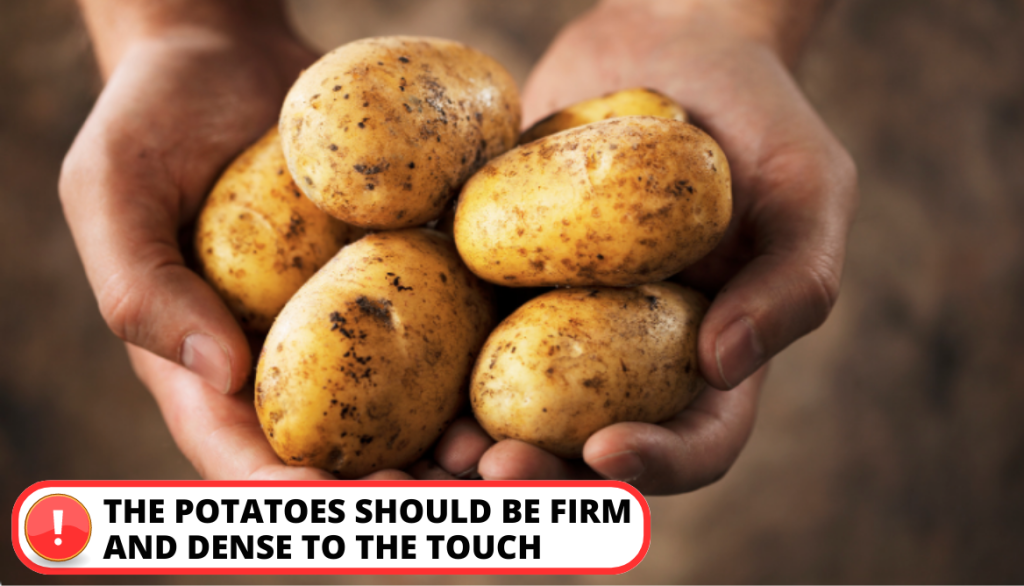
2. Smooth Potato Skin
Look for potatoes with smooth and unblemished skin. Rough or wrinkled skin, as well as cuts or cracks, can be signs of damage or improper potato storage.
3. Free of Bruises or Injuries
Inspect the potatoes for any bruises, cuts, or discoloration. Potatoes with these marks are more susceptible to rotting and may have compromised quality.
4. No Sprouting
Check for any signs of sprouting, which can indicate that the potato is past its prime. Fresh potatoes should be free from sprouts or have only minimal sprouting.
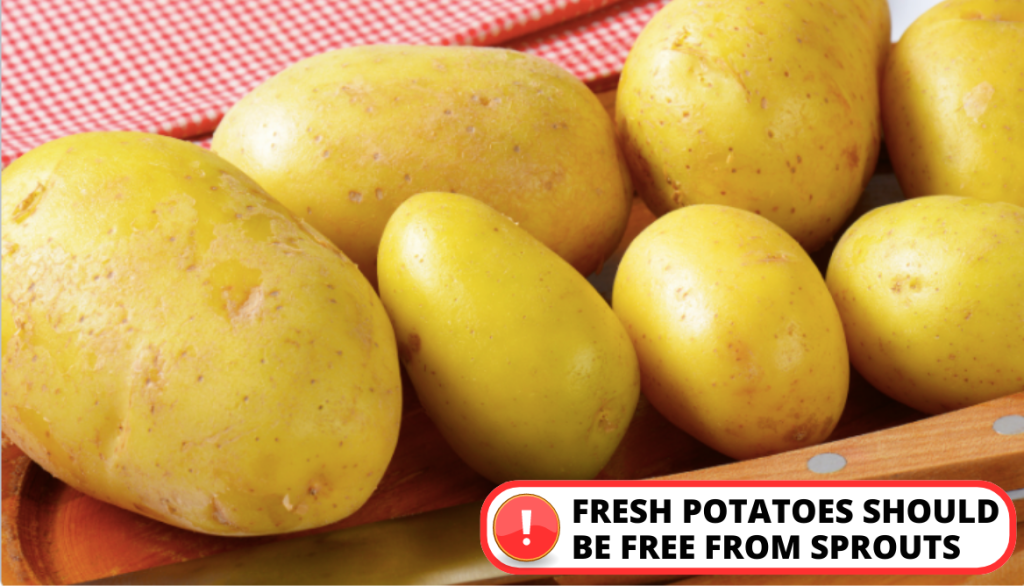
5. Variety
Potatoes come in various varieties, each with its own characteristics and best uses. Some common best varieties include:
- Russet;
- Yukon gold;
- Red potatoes;
- Fingerling potatoes.
Familiarize yourself with different potato varieties and their respective qualities to choose the one that suits your preferences and recipes.
6. Organic Options
Nothing compares to eating organic food. It is recommended to grow potatoes at home because one cannot neglect the planting methods when looking for the healthiest and freshest potatoes.
You can decide to produce them without using artificial fertilizers and pesticides, which may be a key consideration for certain reasons.
What Makes Your Potatoes Green
You might occasionally discover green potatoes among your stored potato tubers and question what might have caused them or possibly if you can eat them.
Here is an explanation of it:
- Green potatoes are caused by the natural toxic alkaloid called solanine, which develops as a defense mechanism in potatoes.
- When exposed to light potatoes undergo a process called greening, resulting in the accumulation of chlorophyll and solanine in the green areas of the potato.
- While chlorophyll is harmless, excessive solanine can be toxic if consumed in high amounts. So, It is generally not recommended to eat them, especially the green parts.
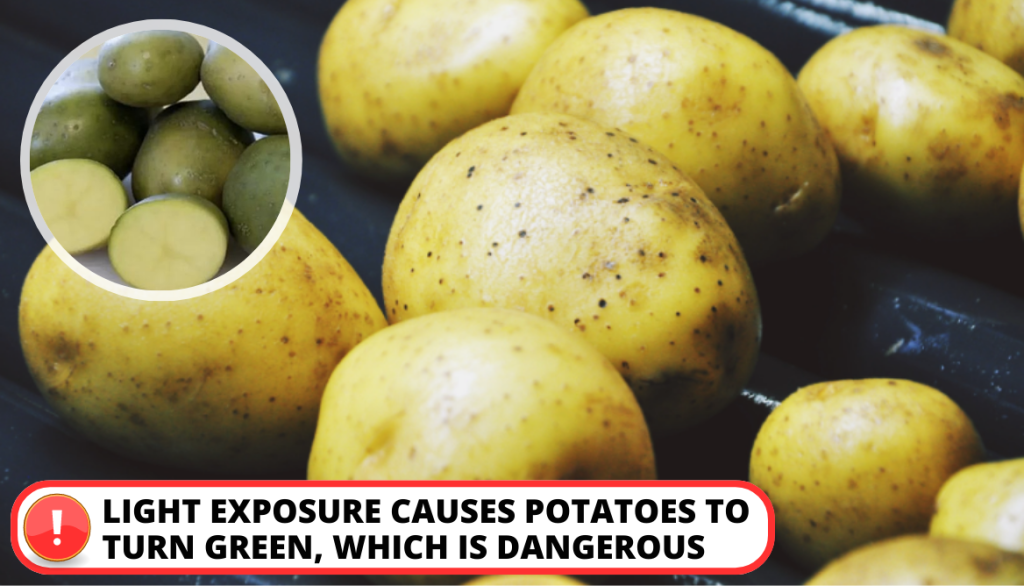
FAQ
Should you rinse potatoes before storing them?
It is recommended not to rinse potatoes before storing them. However, if your potatoes are excessively dirty or muddy, you can gently use a vegetable brush to clean off the dirt before storing them.
How do you prepare potatoes for storage?
To prepare potatoes for storage, cure them for two weeks, sort and discard damaged ones, and gently remove excess dirt. Store unwashed potatoes in a breathable container in a cool, dark, and well-ventilated area.
How do you store washed uncooked potatoes?
To store washed uncooked potatoes, ensure they are thoroughly dried before placing them in a well-ventilated container in a cool, dark location. Also, Inspect them regularly for signs of spoilage.
Do you wash fresh potatoes?
It is advised to wash fresh potatoes right before using them, rather than washing them in advance and storing them wet. Washing potatoes removes dirt, debris, and any pesticide residues present on the skin. It is best to avoid washing them until you’re ready to cook or consume them.
Is it better to store potatoes washed or unwashed?
It is better to store potatoes unwashed. The natural protective layer on the potato skins helps to prevent moisture loss and prolong their storage life.
Conclusion
It depends on several variables whether to wash potatoes before keeping them. If the potatoes are clean and free from pollutants, washing may not be essential. However, if they have been exposed to dirt or pesticides during harvest, washing becomes crucial.
Although, it’s important to strike a balance between maintaining cleanliness and avoiding excessive moisture. Also, storing potatoes after washing requires proper ventilation for maintaining potato quality and preventing issues such as sprouting and rotting.
What are your preferred methods for storing potatoes to maintain their freshness and quality? Let’s know in the comment section. Thanks for reading.
- How to Get Potatoes to Sprout Eyes: Detailed Growing Guide with 3 Options - July 31, 2023
- Weight of a Medium Potato: Revealed in Detailed Guide - July 29, 2023
- Maris Piper Potatoes: 9 Substitutes You Should Know About - July 27, 2023
Hello! I’m Jessica Zander, a garden coach and consultant based in the Boston area (zone 6b), offering virtual consultations across the country and Canada.
I’ve been passionate about gardening since the early 1990s, and in 2022, I launched You Can Do It Gardening to empower individuals to feel more confident in their gardening endeavors.
Following a 30-year career in nonprofit finance and operations, I transitioned out of that field in mid-June of 2023 due to the growing demand for coaching services. Interestingly, my years of presenting financial statements to boards and finance committees proved to be valuable experience for teaching people about gardening! I enjoy sharing skills, providing guidance and suggestions, and collaborating efficiently with clients to make significant improvements to their outdoor spaces, both small and large. I also regularly teach at the Arlington Continuing Education and Cambridge Adult Education.
My approach is direct and practical, akin to Mary Poppins, but tailored to your garden. Clients find satisfaction in saving money and taking pride in their own gardening achievements.

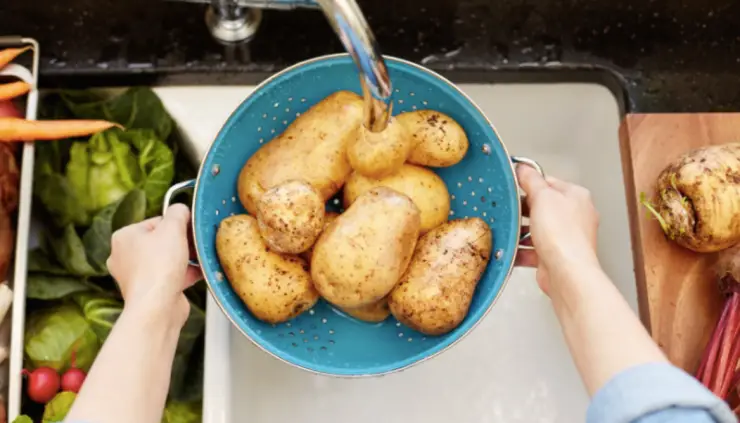
Add comment